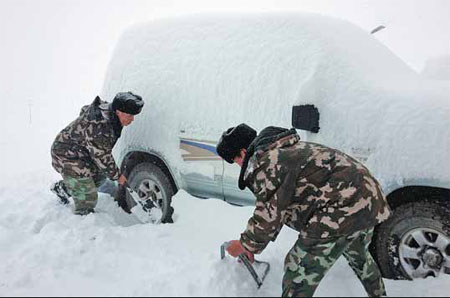Tour operators coming under increasing pressure from rising number of tourists seeking firsthand experience of the mountain, report Wang Huazhong and Da Qiong in Xigaze, Tibet autonomous region
Dazzling sunshine reflected off the snow that covered the deserted northern base camp of Qomolangma, the world's highest mountain. The area is usually packed with tourists enjoying tea in their tents or writing postcards to friends at this time of year. On Friday, however, the only living thing in sight was a black dog wondering around with a rabbit in its mouth.
On Oct 13, the area was struck by a sudden blizzard, which led to the closure of Qomolangma National Park when 154 tourists, 32 of them from overseas, were rescued by local authorities.
 |
| A Buddhist nun prepares pancakes for people at Rongbuk Monastery, which is close to the base camp of Mount Qomolangma in the Tibet autonomous region. Da Qiong / China Daily |
On Oct 14, a 60-year-old member of an Australian trekking group died after an avalanche hit their camp one day earlier on the eastern side of the mountain, which is called Mount Everest in the West.
A group of trekkers from New Zealand was also trapped by an avalanche and remained out of contact for three days after issuing a distress call on Oct 15.
The government described the heavy snowfall brought by Cyclone Phailin as "unexpected", and locals said it was the worst since 1994.
However, extreme conditions are not the only pressures faced by local tourism operators and the park's managers.
The revenue from tourism in Dingri county in the Tibet autonomous region, where the peak is situated, surged 15.6 times between 2008 and 2012, with a more-than fivefold increase in visitor numbers during the period.
Trekking, an activity far more dangerous than traditional sightseeing, is gaining in popularity and an increasing number of ill-trained, inexperienced tourists are exploring the area around the mountain, according to insiders. That increase in numbers has led the local authorities to ponder how they can provide a safe, high quality service for tourists and expand the industry.
Emergency evacuation
It took 74 rescue workers and four snowplows an entire afternoon and a night to clear the road which was blocked by snow 50 cm deep, preventing the stranded tourists from leaving the danger zone.
Tsering Lhamo said she wept constantly as she worked to prevent the snow from accumulating atop her tent, which was being used as a guesthouse at the camp.
 |
| Police officers from Qomolangma police station work to dig out a car at the base camp, where tourists were stranded by snow. Provided to China Daily |
"We couldn't go anywhere at the time. I was very worried about the guests' safety, because the snow kept falling," said the 43-year-old. "I know from experience that yak tents can be overturned by the strong winds at the camp, but that night three of the six-people tents collapsed under the weight of the snow."
Although Rongbuk Monastery, which is close to base camp, was well stocked with provisions, one tourist, apparently unaware of the situation, called for help via his micro blog, saying, "many people only have enough food for one day".
